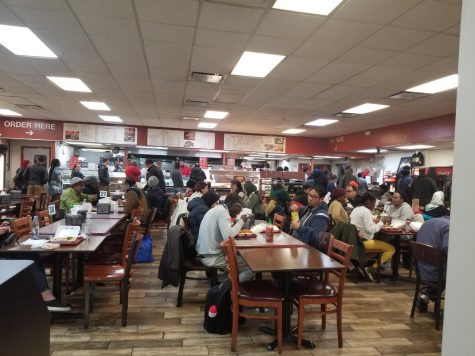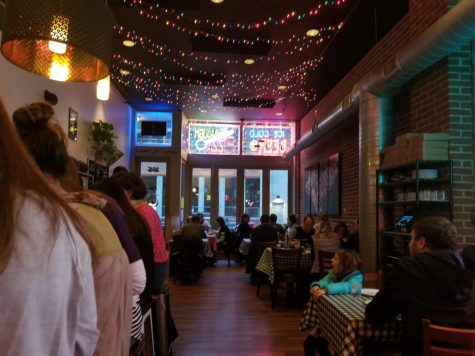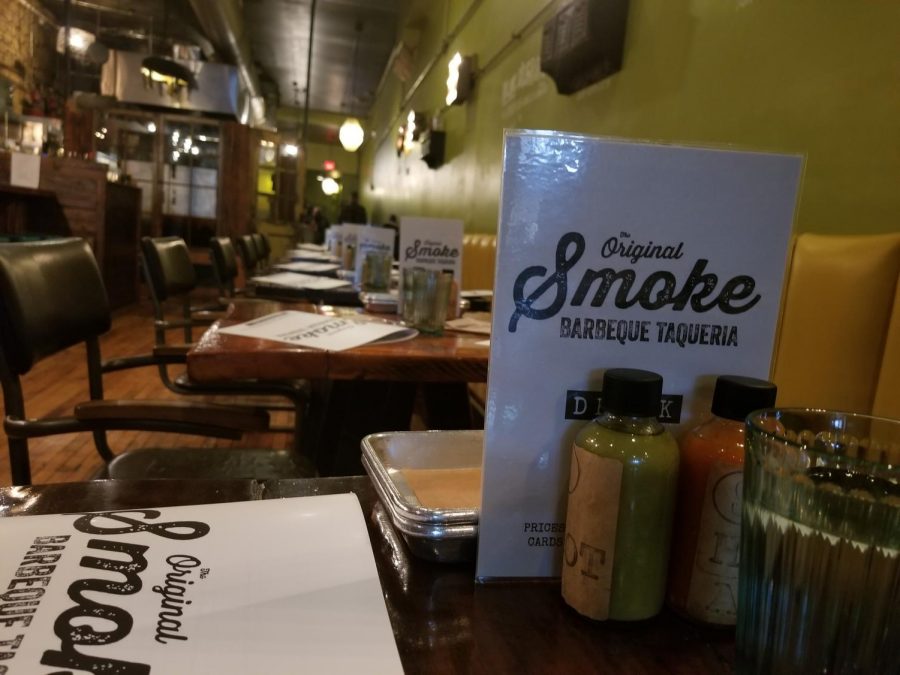Eating Across Bridges: Lawrenceville
A comprehensive culinary guide to Pittsburgh’s hipster-haven
Lawrenceville’s old-style row homes are now inhabited by dozens of unique restaurants.
I grew up crossing many bridges into the city — the Veterans, Fort Pitt, and Smithfield, to name a few. Until recently, however, I had rarely crossed the 31st Street Bridge or the 40th Street Bridge, in between which lies Lawrenceville, a relatively new hub of culture, food, and commerce.
In my defense, that wasn’t entirely my own fault. From its establishment in 1814 to the early 2000s, Lawrenceville was little more than a working-class neighborhood in Pittsburgh’s manufacturing industry — it had some of the highest crime rates in the city, too.
Lawrenceville began to change when the neighborhood’s real estate market began to boom in 2007, with prices appreciating at the second highest rate in the city. However, Lawrenceville was still far from the hipster-haven it is today. That transition didn’t occur until two years later, when UPMC opened its branch hospital in Lawrenceville, relocating many of its Oakland patients and doctors to the new facility. The increased wealth in the area spurred growth in the once worn-down area, spawning dozens of cafes, boutiques, and home decor stores.
Luckily, though, even through the area’s rapid change, Lawrenceville has maintained its diversity and unique identity, something highlighted by my personal favorite cheap, grab-and-go spot, Salem’s Market & Grill. Its menu offers a wonderful variety of Middle Eastern foods, from Lamb Biryani and Goat Curry to Seekh Kebabs and Meat Shawarma. All of the dishes are mouth-wateringly wonderful, but the real soul of the meal isn’t the meat. It’s the spinach, or saag, paneer. The dish binds each of the elements into one wonderful bite: freshly warmed and buttered naan, fatty goat, and, of course, the spinach.

Salem’s market after the mid-afternoon prayer, Jumu’ah.
Next to the curries, biryanis, and kebabs are hamburgers, cheeseburgers, and meatballs — all specified “halal.” In Islam, all meats must be prepared according to the guidelines in the Quran. The animals, for example, must be blessed and then killed by slicing the jugular vein and cannot have been stunned so as to be considered “unhealthy.” The FDA, however, requires stunning in the Safe and Humane Slaughter Act. So while cheeseburgers might seem an oddity at a Middle Eastern market that closes every Friday for Jumu’ah, the workers at Salem’s Market & Grill are simply helping to accommodate one of the many cultures of Lawrenceville.
Salem’s is, however, only the tip of the culinary iceberg in this part of town. It sits adjacent to the 31st Street Bridge, nearly 15 blocks from Lawrenceville proper, and what Bon Appetit ranked the fourth-best new restaurant in the country in 2016, Morcilla. Of the many meals I’ve eaten in Lawrenceville, the Spanish tapas at Justin Severino’s restaurant are, simply put, in a league of their own. The Morcilla menu itself is divided into three sections: snacks, small plates, and large plates. The snacks are only a bite or two in each order, the small plates can be shared — though you won’t want to — and the large plates will easily fill two adults. Ultimately, my group of four ordered four snacks, six small plates, and a single large plate.
The entire meal was fantastic. Our large plate, a rare New York Strip steak with grilled mushrooms and a balsamic grape reduction, forever altered my once-negative opinion of fungi. We had garlic and sherry shrimp whose headless bodies dripped with the flavors of the ocean and a charcuterie board that even Wilbur would eat. But there were two particular snacks that stood out: the oxtail montadito and the roasted Spring Creek oysters.
The oxtail was the first to come, and it was the first to go. The meat itself was a wonderfully braised bite of fatty goodness. The dish, with the gentle crunch of baguette, the creaminess of the Mahon cheese, and the charred sweetness of caramelized onions offered a perfectly satisfying bite. The richness of the oxtail montadito was quickly replaced by an entirely different sensation with the roasted oysters. These particular crustaceans carried the briny crispness of the Atlantic Ocean in which they had lived. The melted Mahon cheese and Iberian chili butter offered a welcome contrast, making the dish a sort of oceanic mac and cheese.
While Morcilla was celebrated by Bon Appetit, a little pizzeria down the street, Driftwood Oven, was publicly endorsed by Chrissy Teigen herself. After a single bite of their Kale Raiser pizza, though, it became clear that their pie could speak for itself. When I went to get pizzas for my family’s dinner, the restaurant was not yet open. That didn’t stop people from lining up early, though — thirty minutes before opening, and there was a line ten deep at the door. The waiting was, however, absolutely worth it.
The two pizzas I ordered were the aforementioned Kale Raiser, a white pizza with shallot-wine cream sauce, bacon, pickled red onions, and toasted kale, and a Roman-style pepperoni pizza. In my last dining article, I commented how Monte Cello’s was “good enough”— and it is. With that said, the Kale Raiser was the best pizza I’ve had in Pittsburgh. Its pickled onions were tart, its bacon was fatty, its kale was vibrant and crisped, and the bite was biblical. For me, however, the simple Roman pepperoni was more indicative of Driftwood Oven’s strengths.
The crust of both pizzas was sourdough. On the Kale Raiser, however, the toppings — good as they were — outshined the solid base. On the Roman pepperoni, the simple, concentrated tomato sauce, the thinly sliced, smoky pepperoni, and the provolone-mozzarella mixture were in a supporting role. The crust had absorbed the flavors and lent its own unique contribution, maintaining the slice’s structural integrity with a savory, crunchy foundation. The dough was the star, and that isn’t something you say often.

Driftwood Oven’s ten table dinning room is sure to fill up quickly.
If, however, tapas and pizza sound unsatisfying, Lawrenceville likely will still have food to tempt you. La Gourmandine, a French bakery, has a lovely assortment of pastries and bread. The chouquettes, light bags of choux dough, manage to sweeten the air inside of them, and are, at only fifty cents apiece, quite addicting. SMOKE Barbeque Taqueria offers a wide variety of soft-shell tacos, with filling ranging from classic chorizo to dangerously good St. Louis ribs. For the carnivore, they also offer pounds of freshly smoked meat, without any distracting features.
There are still more cultures and as many restaurants along in this bustling Pittsburgh neighborhood: Poulet Bleu, a French-American bistro with fine cuisine; Cure, a Mediterranean eatery with a menu that changes daily; and Pusadee’s Garden, an authentic Thai restaurant with an atmosphere to match.
Lawrenceville was named after Captain Lawrence who, in the War of 1812, famously gave the dying command, “Don’t give up the ship.” Today, those words need to be altered slightly: “Lawrenceville, don’t give up the food!”

Jonathan Ross is a senior at NASH. He enjoys brewing kombucha, writing poetry, and starting conversations.


